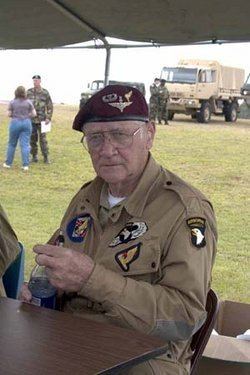Nickname(s) "Jack" Rank Private First Class Years of service 1942–1945 | Allegiance United States Name Jack Agnew | |
 | ||
Born January 2, 1922
Belfast, Northern Ireland ( 1922-01-02 ) Resting Place Forest Hills Memorial Park
Huntington Valley, Pennsylvania Died April 8, 2010, Abington Township, Pennsylvania, United States Unit 506th Infantry Regiment, 101st Airborne Division | ||
Service/branch United States Army | ||
Jack agnew s d day jump
John "Jack" Agnew, United States Army (January 2, 1922 – April 8, 2010) was a United States Army private first class in World War II, a member of the Filthy Thirteen, whose exploits inspired the novel and film The Dirty Dozen.
Contents
Jack agnew meets jake mcniece
Biography
Jack Agnew was a native of Belfast, Northern Ireland, who emigrated with his family in 1927 to Philadelphia, Pennsylvania. Agnew was an original member of the Filthy Thirteen, a unit of the 506th Parachute Infantry Regiment of the 101st Airborne Division. The group parachuted into France on D-Day, June 6, 1944, to remove a bridge over the Douve River. The mission cost most of the men their lives, leaving Agnew wounded. He was awarded the Purple Heart, a Bronze Star with Oak Leaf for subsequent service.
Later in 1944 Agnew's unit of the 506th parachuted into the Netherlands and survived a devastating German counterattack during Operation Market Garden. He then trained as a Pathfinder. His final combat drop was during the Battle of the Bulge, when Agnew and the remaining members of his unit parachuted into Bastogne, Belgium. Agnew used a Eureka beacon to guide the first wave of C-47s during the re-supply mission.
The unit at the time gained attention through a photograph in Stars and Stripes military newspaper. The men had a reputation for getting into trouble and spending time in the stockade. Agnew explained that he and his comrades "weren't murderers or anything, we just didn't do everything we were supposed to do in some ways and did a whole lot more than they wanted us to do in other ways. We were always in trouble." His exploits are recorded in The Filthy Thirteen, Fighting with the Filthy Thirteen, and War Paint; The Filthy Thirteen Jump Into Normandy.
After the war, he attended Drexel University under the G.I. Bill. He was employed by Western Electric, a division of American Telephone and Telegraph. He was interviewed in the 2006 documentary, The Filthy Thirteen: Real Stories from Behind the Lines, a supplement to a DVD release of The Dirty Dozen. Barbara Agnew Maloney said that her father told her that only a third of the film is factual, particularly the part about the capture of the command post during the war games.
In February 2010 Agnew and his daughter, Barbara, traveled to the Military History Show of Shows convention in Louisville, Kentucky, where he was reunited with his unit leader, Jake McNiece, two other of the four surviving members of the "Filthy Thirteen", and three members of Easy Company. The reunion is highlighted in the HBO television series, Band of Brothers. Maloney said that Agnew often told her during childhood that he had "won the war." She said, "We didn't really realize it until the Band of Brothers came out."
Agnew died of heart disease at Abington Memorial Hospital in Abington, Montgomery County, Pennsylvania. He had become ill at his home in the Maple Village retirement community in Hatboro, Pennsylvania. Agnew was survived by his wife, the former Elizabeth "Betty" Potts; a second daughter, Lynne Cooper, five grandchildren, and two great-grandchildren.
